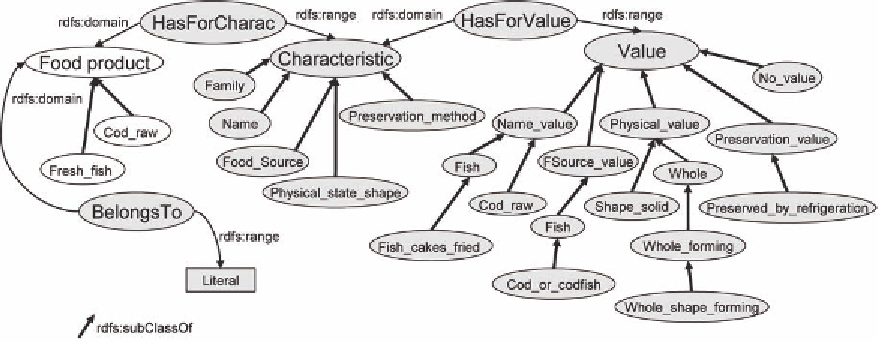Database Reference
In-Depth Information
Figure 10. An excerpt of the extended version of the CONTA ontology
BACKGROUND
Food product presented in Figure 2 is extended
with the Langual vocabulary (colored in grey)
which permits to describe the food product.
The CONSO ontology has the same structure.
It is restricted to the symbolic type FoodProduct
and associated vocabulary used to describe the
food product. This food description vocabulary
is extracted from the TNS WORLD PANEL
data source. As for the Langual vocabulary, it
is composed of a food characterization list and
predefined associated values.
Our ontology alignment process consists in
considering the ontology alignment problem
as a rule application problem in which the food
descriptions of the CONSO ontology and the
food descriptions of the CONTA ontology are put
together into a fact base and in which rules are
defined from the food descriptions of the CONTA
ontology. The different steps of our ontology align-
ment process are detailed in Buche & al. (2008).
At the end of our ontology alignment process, food
products of the CONSO ontology are annotated
by sets of food products of the CONTA ontology
that are candidates for the alignment.
The contribution of our system can be evaluated
as an application in the field of food safety or as
methods in semantic annotation, flexible querying
and ontology alignment.
In the field of food safety, a lot of sources of in-
formation are available on the Web (see McMeekin
& al. (2006) for a recent review). Many efforts
have been done to standardize and to classify the
food product names used to index the data in those
sources at an international level (see Ireland &
Moller (2000) for a review). Recent works have
also proposed to build ontologies using Semantic
Web languages (Soergel & al., 2004). But, for the
best of our knowledge, we think that our approach,
which permits to semi-automatically integrate
data extracted from heterogeneous sources us-
ing semantic annotation and ontology alignment
methods, is an original contribution.
We have chosen to build an unsupervised
annotation system which recognizes predefined
relations in tables: first, the ontology can be eas-
ily built from explicit metadata associated with
relational local databases, which correspond to the
relational schemas of the databases and their attri-
butes with their associated domains. This approach

Search WWH ::

Custom Search